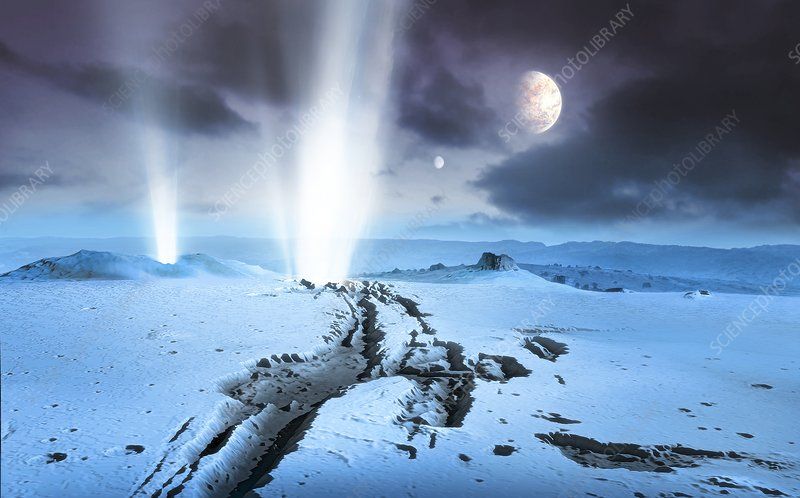
Astronomers Have Formula for Finding Subsurface Oceans in Exomoons
Article by Erik Arends April 23, 2020 (phys.org)
• In the search for extraterrestrial life, we have typically looked at Earth-like planets at a distance from their parent star where the temperature is between the freezing and boiling point of water. But as in our own solar system, most of the liquid water seems to be outside of this ‘habitable zone’ on moons where interior water is heated beyond the melting point by tidal forces.
• In our solar system only Mars and Earth have ‘habitable’ surfaces. But moons within our solar system, such as Enceladus, Europa and six other moons of Jupiter, Saturn, Uranus and Neptune, are examples of celestial bodies that are freezing cold on the surface but may harbor habitable subsurface oceans.
• Researchers from SRON Netherlands Institute for Space Research and the University of Groningen (RUG) have derived a formula that indicates whether a subsurface ocean is present on an ‘exomoon’ and how deep it is. Adding moons to the equation, exoplanet hunters have a much larger field of potentially habitable places to search for extraterrestrial life. In fact, “there could be four times as many habitable exomoons as exoplanets,” says lead author Jesper Tjoa.
• The formula analyzes factors including the diameter of the moon, the distance to its planet, the thickness of the gravel layer on the surface, and the thermal conductivity of the ice or soil layer below the surface to provide a lower limit for the ocean depth.
• Just as “astronomers study starlight shining through the atmospheres of exoplanets” to identify oxygen, for example, says Tjoa, future telescopes “may see geysers like on Enceladus, stemming from a subsurface ocean”, as an indication of life there.
So far, the search for extraterrestrial life has focused on planets at a distance from their star where liquid water is possible on the surface. But within

our Solar System, most of the liquid water seems to be outside this zone. Moons around cold gas giants are heated beyond the melting point by tidal forces. The search area in other planetary systems therefore increases if we also consider moons. Researchers from SRON and RUG have now found a formula to calculate the presence and depth of subsurface oceans in these ‘exomoons.”
In the search for extraterrestrial life, we have so far mainly looked at Earth-like planets at a distance from their parent star where the temperature is between the freezing and boiling point of water. But if we use our own Solar System as an example, moons look more promising than planets. Enceladus, Europa and about six other moons of Jupiter, Saturn, Uranus and Neptune may harbor a subsurface ocean. They all reside far outside the traditional habitable zone—it is literally freezing cold on the surface—but tidal interaction with their host planet heats up their interior.
With moons entering the equation, exoplanet hunters such as the future PLATO telescope—which SRON is also working on—gain hunting ground regarding the search for life. When astronomers find a so-called exomoon, the main question is whether liquid water is possible. Researchers from SRON Netherlands Institute for Space Research and the University of Groningen (RUG) have now derived a formula telling us whether there is a subsurface ocean present and how deep it is.
FAIR USE NOTICE: This page contains copyrighted material the use of which has not been specifically authorized by the copyright owner. ExoNews.org distributes this material for the purpose of news reporting, educational research, comment and criticism, constituting Fair Use under 17 U.S.C § 107. Please contact the Editor at ExoNews with any copyright issue.
Earth, Enceladus, Europa, Exomoons, habitable zone, Jesper Tjoa, Jupiter, Mars, Neptune, Saturn, SRON Netherlands Institute for Space Research, Subsurface Oceans, tidal forces, University of Groningen, Uranus